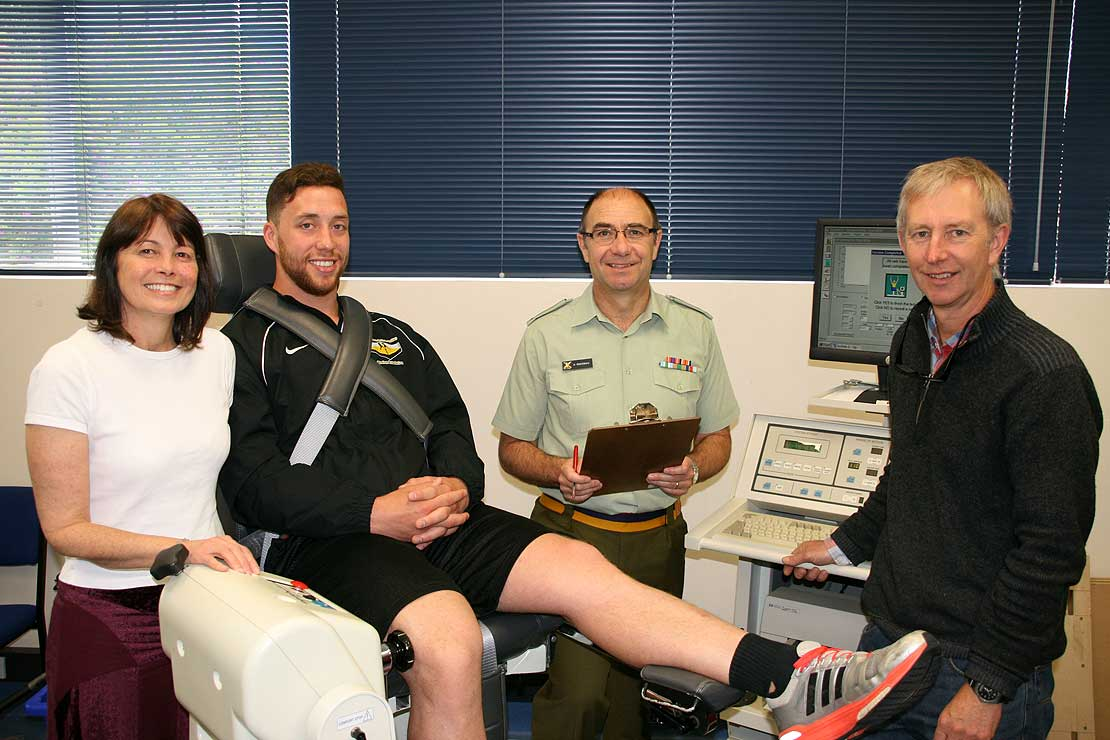- Physical Medicine Home
- Products
- Programs
- Applications
- Find a Clinic
- Blog
- Events
- Education & Training
- In The News
- Press Releases
In The News
< back to resultsHow to reduce soldiers' lower limb injuries
November 9, 2015, 5:00am
Chance Crawford-Nicholson (seated) undergoes strength-testing on the biodex under the supervision of senior lecturer from the School of Sport and Exercise, Dr Sally Lark, and (second from right) PhD candidate Major Jacques Rousseau, from the New Zealand Defence Force and his colleague Lieutenant Colonel Andrew Dunn.
Massey University and the New Zealand Defence Force are carrying out research to determine what causes the high number of lower limb injuries in army soldiers.
“The New Zealand Army requested the study with a view to bringing down the number of lower limb injuries, which have a significant impact on the Defence Force with the loss of manpower and training and duty time. Injuries mean soldiers are unable to be deployed or may need to be discharged from service, and medical costs increase too.
The research is being carried out by Massey’s School of Sport and Exercise senior lecturer Dr Sally Lark, Professor Hugh Morton, Major Jacques Rousseau and Lieutenant Colonel Andrew Dunn.
Major Rousseau, who is doing his PhD with Massey University in Wellington, is investigating the trends and causes of injury, and trialling interventions to reduce damage. He says the information will be vital for the Defence Force. “This research needs to be done. We can’t have a contingent of soldiers unable to do their duty due to injury.
“Preliminary analysis shows a high number of all New Zealand Army soldiers report being injured each year. A significant number of these injuries are in the lower limb region of the body, and this rate has remained relatively unchanged over the last eight years. Regardless of many interventions over the years, (change of boots, introducing orthotics, change in some training practices), the statistics for lower limb injuries remain a consistently high proportion of all injuries sustained.”
Major Rousseau says the exact causes are not yet known, but there is speculation the type of boot soldiers wear could be a problem. “Physical training regimes were also reviewed to see if they were addressing the number of lower limb injuries. The research team is only just now able to start analysing the data on the causes, which is already indicating some promising results.”
Dr Lark is confident the team will be able to pinpoint the cause so they can begin to trial particular interventions. “It’s been an important process to properly identify and examine the problem and not rush into any remedial initiatives. It’s encouraging that the Army is engaging with research and are very pro-active where the health of our soldiers is at stake.”
The outcome for this research will impact on the policy for fitness at enlistment and training regimes of new recruits, boot types and physical training exercises. It will save the Defence Force money and enable it to take better care of their soldiers. This research has gained considerable interest from Defence Forces in Australia, Canada, and America, where they experience similar issues. Massey and the New Zealand Defence Force are leading the research in this area. The final phase of the research will be done as an international collaborative project with the Australian Defence Force."




